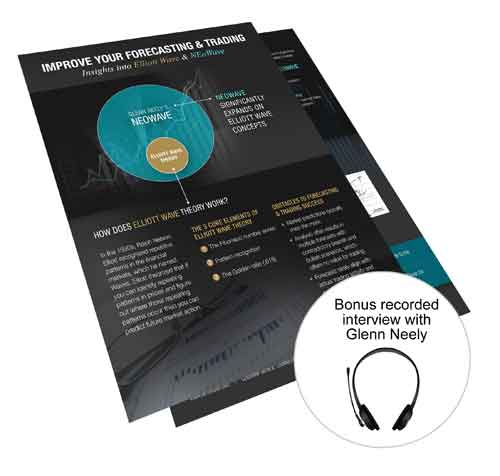NEoWave Blog
12/5/2019 - NEoWave Staff
Article #6 of 7: Glenn Neely addresses the popular question of 'Elliott Wave EFs'
Introductory note: This is Part 6 of a 7-part series. In these articles, Glenn Neely, NEoWave founder and author of Mastering Elliott Wave, discusses Elliott Wave concepts from his unique point of view as a world-renowned Elliott Wave expert. In this frank, open, and insightful interview, Mr. Neely reveals his advanced forecasting and trading concepts – based on his decades of experience as the creator of NEoWave forecasting and his exciting Neely River Trading Technology, which fuels profitable trading results.
When fielding questions from my clients, a common question relates to Elliott Wave and ETFs. Wave theory can be applied to major stock market indexes. It can be applied to ETF sectors and categories. It can be applied to stocks, but I would not recommend it. Normally I would only limit that to major stocks, not small companies that are just getting started.
If you’re going to use orthodox Elliott Wave or
NEoWave forecasting for market analysis, I would stick to the S&P, the Dow, NASDAQ – the major indexes. Then you get down to ETFs, you might want to do the SPY, SMH (the semiconductor index), SKYY (cloud computing), consumer staples is XLP, real estate includes VNQ, and in the utility sector ETFs like XLU.
This way you’re dealing with a lot of different stocks combined together to create a really large index, so you’re not dealing with individual fund managers or individual companies’ CEOs. When it comes to an individual company, a lot of things can go wrong. You can have really bad news ranging from potential theft, mismanagement and record-keeping problems – an event or situation that seriously impacts an individual company.
But when you bunch several together into one ETF, then it smooths things out and it makes Elliott Wave analysis safer and easier. If you’re going to do Wave analysis, I would only stick with ETFs, sectors, large indexes, and entire countries. I would not trade individual stocks. I would definitely consider using Elliott Wave or
NEoWave for ETFs, and I would recommend picking one major ETF.
SPDR ETFs are a good place to start. Anything that starts with an “X” is an SPDR (for example, XOP, XLY). These are some of the sectors you could make charts of and plot out your Elliott Wave patterns. I would start with a monthly timeframe to see whether they are trending up or down on a monthly basis and whether there is potential. For example: Are you in a second Wave before a third-Wave advance? Are you in a fourth Wave before a fifth-Wave advance? Then you can look to trade that particular ETF when the timing is right.
Remember, there are 3 phases to successful trading, and this strategy would be based on the first phase of choosing the markets, identifying the trends, and clarifying which direction you want to trade. Phase 2 adds a critical component – timing – and you can use the
NEoWave Forecasting service to address timing. You can’t really time markets with Elliott Wave, but you can time with the
NEoWave Trading service to decide when you’re going to get in and where to put your stops.
Next, you would wait for the five-Wave move to finish – or whatever pattern you’re in to finish – then look to start getting out of that trade.
Read the articles in this 7-part series:
Article #1,
Article #2,
Article #3,
Article #4,
Article #5,
Article #6,
Article #7,
Get 2 educational tools FREE!
Get Real-World Advice for Better Forecasts and Trades for FREE! Sign Up Now!
Learn more about:
NEoWave Trading Service
NEoWave Forecasting Service
Mastering Elliott Wave by Glenn Neely
Follow us @NEoWaveTheory:
Twitter: https://twitter.com/NEoWaveTheory
Facebook: https://www.facebook.com/NEoWaveTheory


